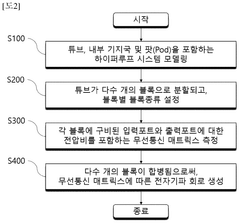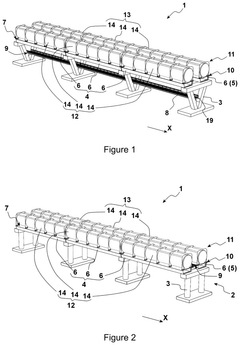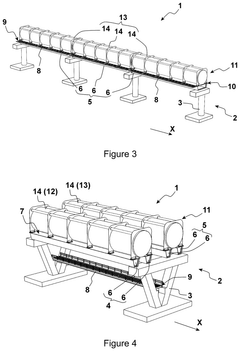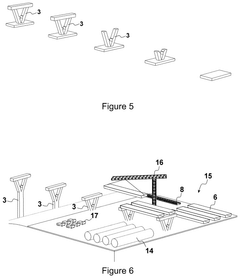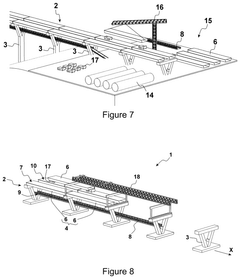Overview of Transverse Wave Dynamics in Hyperloop Transportation Concepts
JUL 29, 20259 MIN READ
Generate Your Research Report Instantly with AI Agent
Patsnap Eureka helps you evaluate technical feasibility & market potential.
Hyperloop Wave Dynamics Background and Objectives
The concept of Hyperloop transportation, first introduced by Elon Musk in 2013, has revolutionized the way we envision high-speed ground transportation. At its core, the Hyperloop system relies on the principles of transverse wave dynamics to achieve unprecedented speeds and efficiency. This technological breakthrough aims to transport passengers and cargo through low-pressure tubes at near-supersonic velocities, potentially transforming long-distance travel and logistics.
The evolution of Hyperloop technology builds upon decades of research in magnetic levitation, vacuum tube transport, and aerodynamics. Its development trajectory has been marked by significant milestones, including the successful test runs of prototype pods and the establishment of several companies dedicated to bringing this futuristic mode of transportation to reality. The primary objective of Hyperloop technology is to create a sustainable, high-speed transportation system that can compete with, and potentially surpass, the efficiency of air travel for medium-range distances.
Transverse wave dynamics play a crucial role in the Hyperloop concept. These waves, which oscillate perpendicular to the direction of energy transfer, are fundamental to the system's propulsion and stability. By harnessing and controlling these waves, engineers aim to minimize energy loss and maximize the pod's speed and efficiency within the tube environment. The study of these dynamics is essential for overcoming challenges such as air resistance, vibration, and maintaining stability at high velocities.
The technical goals associated with transverse wave dynamics in Hyperloop systems are multifaceted. They include optimizing the pod's aerodynamic design to reduce drag, developing advanced propulsion systems that leverage electromagnetic fields, and creating sophisticated control mechanisms to manage the complex wave interactions within the tube. Additionally, researchers are focused on enhancing the overall system's safety, reliability, and energy efficiency through a deeper understanding of these wave dynamics.
As the Hyperloop concept continues to evolve, the exploration of transverse wave dynamics remains at the forefront of research and development efforts. Scientists and engineers are working to refine theoretical models, conduct extensive simulations, and perform real-world tests to push the boundaries of what is possible in high-speed ground transportation. The ultimate aim is to create a transportation system that not only revolutionizes travel but also contributes to a more sustainable and interconnected global infrastructure.
The evolution of Hyperloop technology builds upon decades of research in magnetic levitation, vacuum tube transport, and aerodynamics. Its development trajectory has been marked by significant milestones, including the successful test runs of prototype pods and the establishment of several companies dedicated to bringing this futuristic mode of transportation to reality. The primary objective of Hyperloop technology is to create a sustainable, high-speed transportation system that can compete with, and potentially surpass, the efficiency of air travel for medium-range distances.
Transverse wave dynamics play a crucial role in the Hyperloop concept. These waves, which oscillate perpendicular to the direction of energy transfer, are fundamental to the system's propulsion and stability. By harnessing and controlling these waves, engineers aim to minimize energy loss and maximize the pod's speed and efficiency within the tube environment. The study of these dynamics is essential for overcoming challenges such as air resistance, vibration, and maintaining stability at high velocities.
The technical goals associated with transverse wave dynamics in Hyperloop systems are multifaceted. They include optimizing the pod's aerodynamic design to reduce drag, developing advanced propulsion systems that leverage electromagnetic fields, and creating sophisticated control mechanisms to manage the complex wave interactions within the tube. Additionally, researchers are focused on enhancing the overall system's safety, reliability, and energy efficiency through a deeper understanding of these wave dynamics.
As the Hyperloop concept continues to evolve, the exploration of transverse wave dynamics remains at the forefront of research and development efforts. Scientists and engineers are working to refine theoretical models, conduct extensive simulations, and perform real-world tests to push the boundaries of what is possible in high-speed ground transportation. The ultimate aim is to create a transportation system that not only revolutionizes travel but also contributes to a more sustainable and interconnected global infrastructure.
Market Analysis for Hyperloop Transportation
The Hyperloop transportation concept has garnered significant attention in recent years, presenting a potentially disruptive innovation in the transportation sector. Market analysis reveals a growing interest in high-speed, energy-efficient transportation solutions, with the Hyperloop positioned as a promising alternative to traditional modes of travel.
The global transportation market is experiencing a shift towards sustainable and rapid transit options, driven by increasing urbanization, environmental concerns, and the need for faster connectivity between major economic hubs. The Hyperloop market is expected to capitalize on these trends, offering speeds of up to 700 mph (1,127 km/h) while promising reduced energy consumption and lower carbon emissions compared to existing high-speed rail and air travel options.
Several key factors are influencing the potential market demand for Hyperloop transportation. Firstly, the increasing need for rapid intercity and interstate travel in densely populated regions is creating opportunities for Hyperloop systems to address congestion and reduce travel times. Secondly, the growing emphasis on reducing carbon footprints in the transportation sector aligns well with the Hyperloop's purported environmental benefits, potentially attracting environmentally conscious consumers and businesses.
The market for Hyperloop technology extends beyond passenger transportation, with potential applications in freight transport. The ability to move goods quickly and efficiently between major distribution centers could revolutionize supply chain logistics, offering significant economic benefits to industries reliant on just-in-time delivery systems.
However, the market faces several challenges that could impact adoption rates. The high initial infrastructure costs associated with Hyperloop systems may limit implementation to high-traffic corridors where the investment can be justified. Additionally, regulatory hurdles and safety concerns need to be addressed to gain public trust and government approval for widespread deployment.
Despite these challenges, market projections for Hyperloop technology remain optimistic. The potential for reduced travel times, increased energy efficiency, and lower operational costs in the long term are driving interest from both public and private sectors. Several countries, including the United States, United Arab Emirates, and India, have expressed interest in developing Hyperloop systems, indicating a global market opportunity.
As the technology matures and demonstration projects prove feasibility, the market for Hyperloop transportation is expected to grow. The integration of advanced technologies such as artificial intelligence, IoT, and autonomous systems within Hyperloop concepts could further enhance its market appeal, positioning it as a cornerstone of future smart transportation networks.
The global transportation market is experiencing a shift towards sustainable and rapid transit options, driven by increasing urbanization, environmental concerns, and the need for faster connectivity between major economic hubs. The Hyperloop market is expected to capitalize on these trends, offering speeds of up to 700 mph (1,127 km/h) while promising reduced energy consumption and lower carbon emissions compared to existing high-speed rail and air travel options.
Several key factors are influencing the potential market demand for Hyperloop transportation. Firstly, the increasing need for rapid intercity and interstate travel in densely populated regions is creating opportunities for Hyperloop systems to address congestion and reduce travel times. Secondly, the growing emphasis on reducing carbon footprints in the transportation sector aligns well with the Hyperloop's purported environmental benefits, potentially attracting environmentally conscious consumers and businesses.
The market for Hyperloop technology extends beyond passenger transportation, with potential applications in freight transport. The ability to move goods quickly and efficiently between major distribution centers could revolutionize supply chain logistics, offering significant economic benefits to industries reliant on just-in-time delivery systems.
However, the market faces several challenges that could impact adoption rates. The high initial infrastructure costs associated with Hyperloop systems may limit implementation to high-traffic corridors where the investment can be justified. Additionally, regulatory hurdles and safety concerns need to be addressed to gain public trust and government approval for widespread deployment.
Despite these challenges, market projections for Hyperloop technology remain optimistic. The potential for reduced travel times, increased energy efficiency, and lower operational costs in the long term are driving interest from both public and private sectors. Several countries, including the United States, United Arab Emirates, and India, have expressed interest in developing Hyperloop systems, indicating a global market opportunity.
As the technology matures and demonstration projects prove feasibility, the market for Hyperloop transportation is expected to grow. The integration of advanced technologies such as artificial intelligence, IoT, and autonomous systems within Hyperloop concepts could further enhance its market appeal, positioning it as a cornerstone of future smart transportation networks.
Transverse Wave Challenges in Hyperloop Systems
Transverse waves present significant challenges in the development and operation of Hyperloop transportation systems. These waves, characterized by oscillations perpendicular to the direction of travel, can severely impact the stability, safety, and efficiency of pod movement within the low-pressure tube environment.
One of the primary concerns is the potential for transverse wave propagation along the tube structure. As pods travel at high speeds, they generate pressure waves that can induce vibrations in the tube walls. These vibrations, if not properly managed, can lead to resonance effects, amplifying the wave amplitude and potentially compromising the structural integrity of the system.
The interaction between the pod and the tube's internal atmosphere also contributes to transverse wave formation. Even in a near-vacuum environment, residual air molecules can create aerodynamic disturbances that manifest as transverse waves. These disturbances can affect the pod's trajectory and stability, potentially leading to increased energy consumption and reduced passenger comfort.
Another critical challenge is the impact of external factors on transverse wave dynamics. Environmental conditions such as wind, temperature variations, and seismic activity can introduce additional transverse forces on the Hyperloop infrastructure. These external influences can exacerbate existing wave patterns or create new ones, necessitating robust design considerations and active mitigation strategies.
The high-speed nature of Hyperloop travel further complicates the transverse wave challenge. As pods approach or exceed the speed of sound within the tube, complex shock wave interactions can occur, potentially amplifying transverse wave effects. Managing these supersonic phenomena requires advanced modeling and innovative engineering solutions to ensure safe and efficient operation.
Addressing transverse wave challenges in Hyperloop systems demands a multidisciplinary approach. Engineers must consider advanced materials with superior damping properties, innovative structural designs that minimize wave propagation, and active control systems capable of detecting and counteracting transverse oscillations in real-time. Additionally, sophisticated computational fluid dynamics (CFD) simulations and physical testing are essential to predict and mitigate wave-related issues across various operational scenarios.
The successful resolution of transverse wave challenges is crucial for the commercial viability and public acceptance of Hyperloop technology. Overcoming these hurdles will not only enhance the safety and reliability of Hyperloop systems but also contribute to the broader field of high-speed transportation engineering, potentially yielding insights applicable to other modes of rapid transit.
One of the primary concerns is the potential for transverse wave propagation along the tube structure. As pods travel at high speeds, they generate pressure waves that can induce vibrations in the tube walls. These vibrations, if not properly managed, can lead to resonance effects, amplifying the wave amplitude and potentially compromising the structural integrity of the system.
The interaction between the pod and the tube's internal atmosphere also contributes to transverse wave formation. Even in a near-vacuum environment, residual air molecules can create aerodynamic disturbances that manifest as transverse waves. These disturbances can affect the pod's trajectory and stability, potentially leading to increased energy consumption and reduced passenger comfort.
Another critical challenge is the impact of external factors on transverse wave dynamics. Environmental conditions such as wind, temperature variations, and seismic activity can introduce additional transverse forces on the Hyperloop infrastructure. These external influences can exacerbate existing wave patterns or create new ones, necessitating robust design considerations and active mitigation strategies.
The high-speed nature of Hyperloop travel further complicates the transverse wave challenge. As pods approach or exceed the speed of sound within the tube, complex shock wave interactions can occur, potentially amplifying transverse wave effects. Managing these supersonic phenomena requires advanced modeling and innovative engineering solutions to ensure safe and efficient operation.
Addressing transverse wave challenges in Hyperloop systems demands a multidisciplinary approach. Engineers must consider advanced materials with superior damping properties, innovative structural designs that minimize wave propagation, and active control systems capable of detecting and counteracting transverse oscillations in real-time. Additionally, sophisticated computational fluid dynamics (CFD) simulations and physical testing are essential to predict and mitigate wave-related issues across various operational scenarios.
The successful resolution of transverse wave challenges is crucial for the commercial viability and public acceptance of Hyperloop technology. Overcoming these hurdles will not only enhance the safety and reliability of Hyperloop systems but also contribute to the broader field of high-speed transportation engineering, potentially yielding insights applicable to other modes of rapid transit.
Current Transverse Wave Mitigation Strategies
01 Wave propagation analysis in transverse dynamics
This category focuses on the study and analysis of wave propagation in transverse dynamics. It involves examining how transverse waves move through different mediums, their characteristics, and behavior under various conditions. The research in this area aims to understand the fundamental principles governing transverse wave dynamics and their applications in different fields.- Wave propagation analysis in transverse dynamics: This category focuses on the study and analysis of wave propagation in transverse dynamics. It involves examining how transverse waves move through different mediums, their characteristics, and behavior under various conditions. The research in this area aims to understand the fundamental principles governing transverse wave dynamics and their applications in different fields.
- Transverse wave measurement and detection techniques: This point covers various methods and technologies used for measuring and detecting transverse waves. It includes the development of sensors, instruments, and systems designed to capture and analyze transverse wave data accurately. These techniques are crucial for studying wave dynamics in real-world applications and scientific research.
- Control and manipulation of transverse waves: This category encompasses techniques and systems for controlling and manipulating transverse waves. It includes methods for generating specific wave patterns, altering wave characteristics, and directing wave propagation. These advancements have applications in various fields, such as communications, materials science, and energy transmission.
- Modeling and simulation of transverse wave dynamics: This point focuses on the development of mathematical models and computer simulations to study transverse wave dynamics. These tools allow researchers to predict wave behavior, analyze complex wave interactions, and optimize wave-based systems. Advanced modeling techniques contribute to a deeper understanding of wave phenomena and aid in the design of wave-related applications.
- Applications of transverse wave dynamics: This category explores the practical applications of transverse wave dynamics in various fields. It includes the use of transverse waves in communication systems, material testing, energy harvesting, and medical imaging. The research in this area aims to leverage the unique properties of transverse waves to develop innovative solutions and technologies.
02 Transverse wave measurement and detection techniques
This point covers various methods and technologies used for measuring and detecting transverse waves. It includes the development of sensors, instruments, and systems designed to capture and analyze transverse wave dynamics in different environments. These techniques are crucial for studying wave behavior and characteristics in real-world applications.Expand Specific Solutions03 Transverse wave control and manipulation
This category deals with techniques and systems for controlling and manipulating transverse waves. It includes methods for generating, modifying, and directing transverse waves for specific purposes. The research in this area aims to develop advanced technologies for wave control in various applications, such as communications, energy transfer, and material science.Expand Specific Solutions04 Modeling and simulation of transverse wave dynamics
This point focuses on the development of mathematical models and computer simulations for transverse wave dynamics. It involves creating accurate representations of wave behavior using advanced algorithms and computational techniques. These models and simulations are essential for predicting wave patterns, understanding complex interactions, and optimizing wave-based systems.Expand Specific Solutions05 Applications of transverse wave dynamics
This category explores the practical applications of transverse wave dynamics in various fields. It covers the use of transverse waves in areas such as acoustics, optics, telecommunications, and material science. The research in this area aims to leverage the properties of transverse waves to develop innovative technologies and improve existing systems.Expand Specific Solutions
Key Players in Hyperloop Technology Development
The hyperloop transportation concept is in its early developmental stages, with the market still emerging and technology largely unproven at scale. Key players like Hyperloop Technologies, Inc. are driving innovation, but the industry faces significant technical and regulatory challenges. Universities such as Southwest Jiaotong University and Indian Institute of Technology Madras are contributing research to advance the field. While the potential market size is substantial, given the disruptive nature of hyperloop technology, commercial viability remains uncertain. The involvement of established transportation and engineering firms like Siemens AG and CRRC Zhuzhou Locomotive Co., Ltd. suggests growing interest in the technology's long-term prospects.
Hyperloop Technologies, Inc.
Technical Solution: Hyperloop Technologies, Inc. (now Virgin Hyperloop) has developed a comprehensive approach to transverse wave dynamics in their hyperloop concept. They utilize a combination of magnetic levitation and low-pressure tubes to minimize air resistance and friction. Their system employs advanced sensors and control algorithms to detect and mitigate transverse waves that may occur during high-speed travel. The company has conducted extensive simulations and scale model tests to optimize the pod's aerodynamics and structural design, reducing the likelihood of harmful oscillations[1]. They have also implemented active suspension systems that can adjust in real-time to counteract any transverse wave effects, ensuring passenger comfort and safety[2]. Virgin Hyperloop's full-scale test track in Nevada has demonstrated the effectiveness of their wave mitigation strategies at speeds up to 387 km/h (240 mph)[3].
Strengths: Pioneering full-scale testing, advanced sensor integration, and active suspension systems for real-time wave mitigation. Weaknesses: Limited real-world implementation data and potential high infrastructure costs for large-scale deployment.
Southwest Jiaotong University
Technical Solution: Southwest Jiaotong University has made significant contributions to the study of transverse wave dynamics in hyperloop transportation. Their research team has developed sophisticated mathematical models to simulate the behavior of transverse waves in high-speed tube transport systems. They have focused on the interaction between the vehicle and the tube structure, considering factors such as tube stiffness, support spacing, and vehicle suspension characteristics[4]. The university has also conducted experimental studies using scaled-down prototypes to validate their theoretical models. Their findings have led to recommendations for optimal tube design and support configurations to minimize the impact of transverse waves on vehicle stability and passenger comfort. Additionally, they have explored innovative damping technologies, including tuned mass dampers and active control systems, to further reduce wave-induced vibrations[5].
Strengths: Strong theoretical foundation and simulation capabilities, validated by experimental studies. Weaknesses: Limited full-scale testing experience compared to industry players.
Innovative Wave Dynamics Research in Hyperloop
Method for analyzing electromagnetic wave characteristics inside hyperloop tube and computer-readable recording medium having recorded thereon program to perform same
PatentWO2024162578A1
Innovation
- The method involves dividing the hyperloop tube into multiple blocks, measuring wireless communication matrices for each block, and merging them to create an electromagnetic wave circuit, utilizing a computer-readable recording medium with a program to analyze these characteristics accurately, incorporating a processor for modeling, block setting, wireless communication matrix measurement, and electromagnetic wave circuit generation.
Method for erecting a transportation structure
PatentPendingUS20250154734A1
Innovation
- A method involving the erection of a substructure composed of piers and girders, which allows for the transportation and assembly of tube segments using a circulation loop system, enabling construction on rough terrains without the need for ground access.
Safety Regulations for Hyperloop Systems
Safety regulations for Hyperloop systems are crucial to ensure the protection of passengers, personnel, and infrastructure in this innovative transportation concept. These regulations must address the unique challenges posed by the high-speed, low-pressure environment of Hyperloop systems, including the potential risks associated with transverse wave dynamics.
One of the primary safety concerns in Hyperloop systems is the management of transverse waves that may occur within the tube infrastructure. These waves can be generated by various factors, such as thermal expansion, seismic activity, or even the movement of the pods themselves. To mitigate these risks, safety regulations must mandate the implementation of advanced monitoring systems capable of detecting and analyzing transverse wave patterns in real-time.
Furthermore, safety regulations should require the development and implementation of robust structural designs that can withstand and dampen transverse waves. This may include the use of specialized materials and construction techniques to enhance the overall stability and resilience of the Hyperloop tube infrastructure. Additionally, regulations should specify minimum safety factors for structural components to account for potential wave-induced stresses.
Emergency response protocols must also be established to address scenarios involving excessive transverse wave activity. These protocols should outline procedures for rapid pod deceleration, passenger evacuation, and system shutdown in the event of detected anomalies. Safety regulations should mandate regular drills and simulations to ensure that all personnel are prepared to execute these protocols effectively.
The integration of active damping systems within the Hyperloop infrastructure should be a key component of safety regulations. These systems would work to counteract transverse waves in real-time, maintaining the stability of the tube and ensuring a smooth ride for passengers. Regulations should specify performance standards for these damping systems and require regular maintenance and testing to ensure their continued effectiveness.
Safety regulations must also address the potential impact of transverse waves on the levitation and propulsion systems of Hyperloop pods. This may include requirements for redundant systems, fail-safe mechanisms, and adaptive control algorithms capable of compensating for wave-induced perturbations. Additionally, regulations should mandate comprehensive testing and certification processes for all pod components to ensure their ability to function reliably under various wave conditions.
In conclusion, safety regulations for Hyperloop systems must take a holistic approach to addressing the challenges posed by transverse wave dynamics. By incorporating advanced monitoring, structural design, emergency protocols, and active damping systems, these regulations can help ensure the safe and reliable operation of this groundbreaking transportation technology.
One of the primary safety concerns in Hyperloop systems is the management of transverse waves that may occur within the tube infrastructure. These waves can be generated by various factors, such as thermal expansion, seismic activity, or even the movement of the pods themselves. To mitigate these risks, safety regulations must mandate the implementation of advanced monitoring systems capable of detecting and analyzing transverse wave patterns in real-time.
Furthermore, safety regulations should require the development and implementation of robust structural designs that can withstand and dampen transverse waves. This may include the use of specialized materials and construction techniques to enhance the overall stability and resilience of the Hyperloop tube infrastructure. Additionally, regulations should specify minimum safety factors for structural components to account for potential wave-induced stresses.
Emergency response protocols must also be established to address scenarios involving excessive transverse wave activity. These protocols should outline procedures for rapid pod deceleration, passenger evacuation, and system shutdown in the event of detected anomalies. Safety regulations should mandate regular drills and simulations to ensure that all personnel are prepared to execute these protocols effectively.
The integration of active damping systems within the Hyperloop infrastructure should be a key component of safety regulations. These systems would work to counteract transverse waves in real-time, maintaining the stability of the tube and ensuring a smooth ride for passengers. Regulations should specify performance standards for these damping systems and require regular maintenance and testing to ensure their continued effectiveness.
Safety regulations must also address the potential impact of transverse waves on the levitation and propulsion systems of Hyperloop pods. This may include requirements for redundant systems, fail-safe mechanisms, and adaptive control algorithms capable of compensating for wave-induced perturbations. Additionally, regulations should mandate comprehensive testing and certification processes for all pod components to ensure their ability to function reliably under various wave conditions.
In conclusion, safety regulations for Hyperloop systems must take a holistic approach to addressing the challenges posed by transverse wave dynamics. By incorporating advanced monitoring, structural design, emergency protocols, and active damping systems, these regulations can help ensure the safe and reliable operation of this groundbreaking transportation technology.
Environmental Impact of Hyperloop Technology
The environmental impact of Hyperloop technology is a crucial consideration in its development and potential implementation. As a revolutionary transportation concept, Hyperloop promises significant reductions in carbon emissions compared to traditional modes of transport. The system's enclosed tube design and electric propulsion mechanism contribute to minimal air pollution and noise pollution during operation.
One of the primary environmental benefits of Hyperloop is its potential for energy efficiency. The low-pressure environment within the tubes reduces air resistance, allowing for high-speed travel with minimal energy consumption. This efficiency could lead to substantial reductions in greenhouse gas emissions, particularly when compared to air travel and long-distance road transportation.
The construction of Hyperloop infrastructure, however, presents environmental challenges. The extensive network of tubes and supporting structures required for a Hyperloop system would necessitate significant land use and potential habitat disruption. Careful route planning and environmental impact assessments would be essential to minimize these effects and ensure responsible development.
Material selection for Hyperloop components also plays a crucial role in its environmental footprint. The use of sustainable and recyclable materials in tube construction, pod design, and supporting infrastructure could significantly reduce the system's overall environmental impact. Additionally, the integration of renewable energy sources to power Hyperloop operations could further enhance its eco-friendly credentials.
The potential for Hyperloop to reduce congestion in urban areas and between cities could have indirect environmental benefits. By providing a fast and efficient alternative to road and air travel, Hyperloop could help alleviate traffic congestion and reduce the need for road expansion projects, which often have significant environmental consequences.
Consideration must also be given to the lifecycle environmental impact of Hyperloop technology. This includes the environmental costs of manufacturing, installation, maintenance, and eventual decommissioning of the system. Long-term studies and lifecycle assessments would be necessary to fully understand and mitigate these impacts.
In conclusion, while Hyperloop technology offers promising environmental benefits through reduced emissions and energy efficiency, careful planning and sustainable practices are essential to ensure its overall positive environmental impact. Balancing the potential benefits with the challenges of infrastructure development and resource use will be key to realizing Hyperloop's potential as an environmentally friendly transportation solution.
One of the primary environmental benefits of Hyperloop is its potential for energy efficiency. The low-pressure environment within the tubes reduces air resistance, allowing for high-speed travel with minimal energy consumption. This efficiency could lead to substantial reductions in greenhouse gas emissions, particularly when compared to air travel and long-distance road transportation.
The construction of Hyperloop infrastructure, however, presents environmental challenges. The extensive network of tubes and supporting structures required for a Hyperloop system would necessitate significant land use and potential habitat disruption. Careful route planning and environmental impact assessments would be essential to minimize these effects and ensure responsible development.
Material selection for Hyperloop components also plays a crucial role in its environmental footprint. The use of sustainable and recyclable materials in tube construction, pod design, and supporting infrastructure could significantly reduce the system's overall environmental impact. Additionally, the integration of renewable energy sources to power Hyperloop operations could further enhance its eco-friendly credentials.
The potential for Hyperloop to reduce congestion in urban areas and between cities could have indirect environmental benefits. By providing a fast and efficient alternative to road and air travel, Hyperloop could help alleviate traffic congestion and reduce the need for road expansion projects, which often have significant environmental consequences.
Consideration must also be given to the lifecycle environmental impact of Hyperloop technology. This includes the environmental costs of manufacturing, installation, maintenance, and eventual decommissioning of the system. Long-term studies and lifecycle assessments would be necessary to fully understand and mitigate these impacts.
In conclusion, while Hyperloop technology offers promising environmental benefits through reduced emissions and energy efficiency, careful planning and sustainable practices are essential to ensure its overall positive environmental impact. Balancing the potential benefits with the challenges of infrastructure development and resource use will be key to realizing Hyperloop's potential as an environmentally friendly transportation solution.
Unlock deeper insights with Patsnap Eureka Quick Research — get a full tech report to explore trends and direct your research. Try now!
Generate Your Research Report Instantly with AI Agent
Supercharge your innovation with Patsnap Eureka AI Agent Platform!


